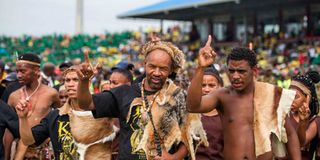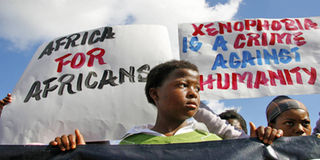Part 2: The roots of xenophobia in South Africa

Members of the Khoisan community. The original occupants of what is now South Africa have now been pressed into a decreasing part of neighbouring Botswana to the north-west and Namibia to the west. AFP PHOTO / MUJAHID SAFODIEN
What you need to know:
- For the San, arguably the First of all First Peoples, interactions with migrants, African or later European, have been almost uniformly disastrous.
- When Europeans, Dutch mainly at first, began arriving on the southern tip of Africa in the mid-1650s, the San had already been forced to the fringes of most of the best lands of southern Africa by fellow Africans who had arrived in preceding centuries from further north.
- Scorned by Bantu-speakers, the San were treated as "vermin" by white European settlers, who did not understand the San's view of nature and who resented their livestock being hunted or taken by San hunter-gatherers who did not use the idea of property and ownership in their culture.
Long before any white settlers arrived on the southern tip of Africa, indigenous original occupants of this land had been pushed to the fringes by incoming waves of settlers from lands in central and eastern Africa.
The original occupants of what is now South Africa – ironically now pressed into a decreasing part of neighbouring Botswana to the north-west and Namibia to the west – were the San, also called the Khoekhoe (Khoikhoi) or, pejoratively, Bushmen, as European settlers referred to them.
Not related to the Bantu (a word meaning 'the people' or 'human beings'), tribes that now numerically dominate not only South Africa but neighbouring states, the San are descendants of Early Stone Age ancestors.
Clans and loosely connected family groups followed seasonal game migrations between mountain ranges and the coastline, and occupied most of what is today South Africa, as well as most neighbouring states. For thousands of years, they were the only humans in the southern African region.
They made their homes in caves, under rocky overhangs or in temporary shelters. They moved frequently and lived with a theology and philosophy in which, like many First Peoples, they saw themselves as part of the land. They also saw the land and animals as part of their own being, living in integral harmony with the land and its creatures for most of mankind's history.
With little surviving evidence of the details, it was, until recently, conventionally believed that the 'Bantu peoples' initially lived in an area west of the Congo Basin rainforest, around what is today known as the Grassfields region of Cameroon. They began moving southwards and eastwards from 3000 BCE.
In terms of this historic construction, between 1500 BCE and 500 CE, the expanding collective of tribes and groups reached modern-day Angola and KwaZulu-Natal province in southern Africa and the African Great Lakes region in eastern Africa, having traversed the vast Congo rainforest.
Beginning around 500 CE, Bantu-speaking communities spread out in all directions from the African Great Lakes, reaching Sudan and pushing into Kenya, Tanzania, Mozambique and Zimbabwe.
This theory rests on the idea of a slow but continuous expansion of Bantu-speaking and culturally related tribes that now dominate the African sub-Saharan regions.
But this is only one theory.
More recently, there has been a growing belief that the conventional notions of precolonial African tribal formations and their spread had been developed on a fallacy, and that there is no such thing as a 'Bantu people', in the sense that the notion has been used to define a distinct ethnic group or culture.

South Africans protest poor service delivery. Protests led to xenophobic violence. (AFP or licensors)
Researchers are now more likely to refer to the 'Bantu-speaking community', which includes populations that are distinct from one another but which speak one of the 680 languages or language derivatives so far identified and that share a common root tongue.
From 2005-2015, Dr Spencer Wells of the Genographic Project, undertaken by the National Geographic Society, IBM, and the Waitt Foundation, travelled Africa and the world to create a picture of how our ancestors populated the planet by analysing DNA samples.
Genetic data from over 100 countries and many more groups and tribes was used to trace human migrations over the past 50,000-60,000 years, when modern humans are believed to have first migrated out of Africa.
According to Wells, one group of African migrants took a 'southern route' and populated southern India and southeast Asia, and then Australia.
The other major group of African migrants, accounting for 90 percent of the world's non-African population (some 5.4 billion people as of 2014), took a 'northern route', eventually peopling most of Eurasia and occupying the Americas.
In the process of these African expansions, aboriginal groupings in southern India, Sri Lanka and Southeast Asia, and in Africa itself, were displaced.
The same global pattern of movements can be seen historically within Africa, where 'Bantu communities' have moved in waves across the continent, the latest waves emanating from East Africa and seeing related peoples settle in parts of southern Africa and parts of central and eastern Africa, an example being the Tutsis in Rwanda and Burundi.
There are exceptions where aboriginal inhabitants, such as the so-called Pygmies, have adopted Bantu-related languages while being ethnically and genetically distinct.
For the San, arguably the First of all First Peoples, interactions with migrants, African or later European, have been almost uniformly disastrous.
When Europeans, Dutch mainly at first, began arriving on the southern tip of Africa in the mid-1650s, the San had already been forced to the fringes of most of the best lands of southern Africa by fellow Africans who had arrived in preceding centuries from further north.
Scorned by Bantu-speakers, the San were treated as "vermin" by white European settlers, who did not understand the San's view of nature and who resented their livestock being hunted or taken by San hunter-gatherers who did not use the idea of property and ownership in their culture.
Consequently, they were actively hunted down and killed.
There may have been once some tens of thousands of widely dispersed small clan or extended family San groupings across the southern African region.
But by the 20th century, the remnants of a people ravaged by succeeding waves of "foreigners", black and white, had been reduced to a handful of groupings, eking out a living on the edges of the Kalahari and Namib deserts.
Today, about 300 'purebred' San survive, mostly in Botswana, with ever-diminishing areas in which they can practise their most ancient of human skills and culture.
They suffer from disease and malnutrition, with little to no formal education and decreasing sufferance from modern African states, where they find themselves hemmed in, hounded for who they are and often resorting to alcohol for some relief.
The original occupants of what is now South Africa have now been pressed into a decreasing part of neighbouring Botswana to the north-west and Namibia to the west.
The sad story of the San has replayed itself out in numerous ways as the occupation of Africa by Africans has affected aboriginal groupings that sprang up from humanity's most ancient ancestors.
From the time of the arrival of what were first traders, then settlers, from Europe, Africans in every country on the continent but Ethiopia have had to endure centuries of occupation and submission, sometimes brutally, to settler and colonial masters.
Frequently, European powers used tribal differences to forward their agendas, employing the age-old technique of 'divide and conquer'.
In what are now the DRC, Rwanda and Burundi, Belgium colonial powers used tribal differences to force their will on local peoples, setting the scene for multiple outbreaks in the 20th century of genocidal violence between majority Hutus and the Tutsis who were used by the colonial powers as enforcers of rule from afar, while resources, including human beings, were plundered for the benefit of the colonisers.
This history has set the scene for problems across the continent between peoples, once naturally separated by forests or deserts or rivers, but forced artificially into 'colonial era states' with borders that also sometimes cleave communities, and which set up lines of conflict that play out even to this day.
In South Africa, this process was pursued not only by the original Dutch settlers, but the subsequent English colonial masters who used groupings such as the Mfengu, a collective of isiXhosa-speaking communities in the lush coastal areas of what is now the Eastern Cape province, to fight against other groupings who violently opposed increasing white settlement and loss of lands.
Alliances between colonial powers and tribal leaders opposed to powerful indigenous groupings, such as the fierce Zulus of what is now KwaZulu-Natal, Swaziland and parts of northern South Africa and southern Zimbabwe, were employed to help maintain control of the colonies.

Later, self-rule white administrations, followed in 1948 by the aggressively racist apartheid system, continued to use tribal divisions to that same end.
This went on even up to the eve of South Africa's attainment of democratic rule in 1994, with elements of Zulu-speaking migrant workers living in the 'gold lands' of greater Johannesburg being armed and deployed against anti-apartheid forces and formations.
The divisions, racial, tribal and linguistic, that underlay the complex demographics of modern-day South Africa continue to play out. Individuals have found themselves powerless, hopeless and enraged in the country of their birth, suffering travails that are most easily blamed on those who seem to have newly arrived and are somehow "doing better" than those born here.
At one level, xenophobia, as it emerges every few years in South Africa, is as simple as that.
And yet, at the same time, xenophobia is a complex phenomenon that lives in the "fear of the other", a universal human problem and a major driver of conflicts ancient and modern everywhere.
* * * * * *
There are 11 official South African languages, including the 'click languages' used by various San or Khoi-san groups.
The four major ethnic divisions among Black South Africans are the Nguni, Sotho, Shangaan-Tsonga and Venda.
The Nguni represent nearly two-thirds of South Africa's Black population and can be divided into four distinct groups: the Northern and Central Nguni (Zulu-speaking peoples), the Southern Nguni (Xhosa-speaking peoples), the Swazi people from Swaziland and adjacent areas, and the Ndebele people of the Northern Province and Mpumalanga.
Archaeological evidence shows that the Bantu-speaking groups, who were the ancestors of the Nguni, migrated down from East Africa as early as the 11th century.
The last waves of aggressively expansionist migrants moving southwards from East Africa through eastern African coastal zones arrived in what is now KwaZulu-Natal and Mozambique around the time of the first white settlers' arrival in Cape Town from 1652 onwards.
Next: The Poison of Apartheid (May 1, 2022)





